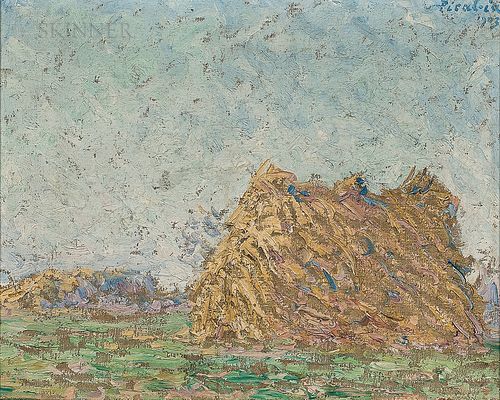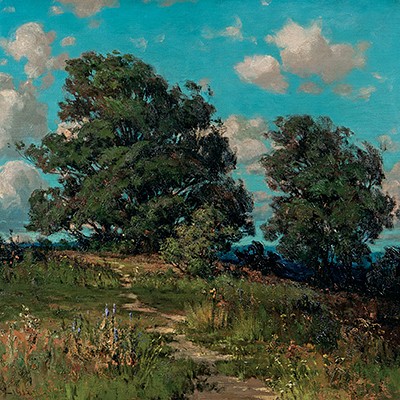Francis Picabia (French, 1879-1953) Moret-sur-Loing
Lot 137
About Seller
Bonhams Skinner
274 Cedar Hill Street
Marlborough, MA 01752
United States
Founded over four decades ago, Bonhams Skinner offers more than 60 auctions annually. Bonhams Skinner auctions reach an international audience and showcase the unique, rare, and beautiful in dozens of categories, including the fine and decorative arts, jewelry, modern design, musical instruments, sc...Read more
Categories
Estimate:
$30,000 - $40,000
Absentee vs Live bid
Two ways to bid:
- Leave a max absentee bid and the platform will bid on your behalf up to your maximum bid during the live auction.
- Bid live during the auction and your bids will be submitted real-time to the auctioneer.
Bid Increments
| Price | Bid Increment |
|---|---|
| $0 | $10 |
| $100 | $25 |
| $500 | $50 |
| $1,000 | $100 |
| $3,000 | $250 |
| $5,000 | $500 |
| $10,000 | $1,000 |
| $30,000 | $2,500 |
| $50,000 | $5,000 |
| $100,000 | $10,000 |
| $300,000 | $25,000 |
| $500,000 | $50,000 |
| $1,000,000 | $100,000 |
About Auction
By Bonhams Skinner
Sep 25, 2020
Set Reminder
2020-09-25 12:00:00
2020-09-25 12:00:00
America/New_York
Bidsquare
Bidsquare : Fine Paintings & Sculpture
https://www.bidsquare.com/auctions/skinner/fine-paintings-sculpture-5569
The auction covers a broad range of Western styles, media, and regions from the 16th century to the present day including paintings, sculpture, and works on paper Bonhams Skinner bidsquare@bonhamsskinner.com
The auction covers a broad range of Western styles, media, and regions from the 16th century to the present day including paintings, sculpture, and works on paper Bonhams Skinner bidsquare@bonhamsskinner.com
- Lot Description
Francis Picabia (French, 1879-1953)
Moret-sur-Loing
Signed and dated "Picabia/1903" u.r., signed and dated "F. Picabia . 1903" on the reverse, signed, titled, and dated on the stretcher.
Oil on canvas, 13 x 16 1/8 in. (33.0 x 41.0 cm), framed.
Condition: Scattered areas of craquelure.
Provenance: Acquired directly from the artist by the grandfather of Louise T. Park; by family descent to the current private collection, Connecticut.
Literature: William A. Camfield, Arnauld Pierre, Candace Clements, and Beverley Calté, Francis Picabia Catalogue Raisonné, vol. 1 (Brussels and New Haven: Mercatorfonds and Yale University Press, 2014), cat. no. 96, illustrated.
N.B. Though he is most often associated with Dadaism and abstraction, Francis Picabia first found success with paintings done in an Impressionist style. His depictions of the French countryside followed suit with the prevailing Impressionist aesthetic at the turn of the century, taking particular inspiration from the work of Claude Monet, Camille Pissarro, and Alfred Sisley. This 1903 example recalls Monet's 1890-91 haystack series. Rather than Monet's Giverny, Picabia found his haystacks in Moret-sur-Loing, a medieval village situated on the banks of the Loing river and on the edge of the forest of Fontainebleau, southeast of Paris—a favorite destination of Sisley. Instead of painting en plein air in the traditional Impressionist fashion, Picabia often devised his scenes of rural France from photographs or even printed postcard reproductions of works by other artists. Both the divergence from group ideology and the use of appropriation would remain central to Picabia's artistic practice throughout his career. Though Picabia's Impressionist oeuvre achieved critical acclaim and commercial success, by 1909 he had transitioned to Neo-Impressionism, then to Fauvism. He continued this trajectory of exploration and evolution, contributing to Cubism, Surrealism, and the Dada movement, all the while maintaining his independence and defying categorization.
Estimate $30,000-40,000
Additional inscriptions on the stretcher include "Property of Howard Gray Park III" and "1878/1953". The artist's obituary and another clipping regarding the artist are affixed to the stretcher, along with a ticket/invitation to the opening for the exhibition Francis Picabia at the Solomon R. Guggenheim Museum, New York, September 17, 1970.
Frame dimensions: 16 3/4 x 19 7/8 x 1 1/2 in.
Items may have wear and tear, imperfections, or the effects of aging. Any condition statement given, as a courtesy to a client, is only an opinion and should not be treated as a statement of fact. Skinner shall have no responsibility for any error or omission. - Shipping Info
-
Please visit http://www.skinnerinc.com/services/payment-and-shipping/ for information regarding the collection of items purchased at auction.
-
- Buyer's Premium



 EUR
EUR CAD
CAD AUD
AUD GBP
GBP MXN
MXN HKD
HKD CNY
CNY MYR
MYR SEK
SEK SGD
SGD CHF
CHF THB
THB





















